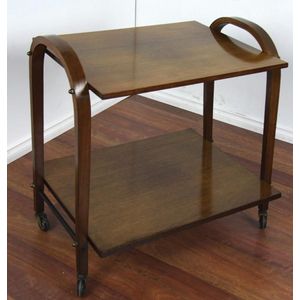French Modernist Walnut Tea Trolley with Castors
You must be a subscriber, and be logged in to view price and dealer details.
Subscribe Now to view actual auction price for this item
When you subscribe, you have the option of setting the currency in which to display prices to $Au, $US, $NZ or Stg.
- Tier - One or more under-shelves of a table or cabinet.
- Castors - Wheels, fitted especially to chair legs, couches, tables and some smaller pieces of furniture, to enable them to be easily moved about. The earliest castors were of brass, with shanks fitting into the base of the leg, and the wheels often made of leather. In the late 18th century, brass 'bucket' or 'cup' castors were introduced, either rounded or square, fitting directly over the end of the leg and held in place with screws. The wheels were generally solid brass. Bucket/cup castors continued in use throughout the 19th century and indeed are still made today. In the later 19th century wheels were sometimes made of wood, china, either white or brown, and sometimes of steel.
- Modernism / Modernist - Modernist furniture and design emerged in the early to mid-20th century as a response to traditional styles of the 19th century and prior times, and a reflection of the technological and social changes of the time. Characteristics of Modernist furniture and design include simplicity and minimalism and clean lines and a lack of unnecessary ornamentation are key features. That form follows function is a fundamental principle of Modernist design, and furniture and objects are designed with a focus on their practical use.
Modernist furniture often incorporates geometric shapes, such as cubes, rectangles, and circles. This reflects a departure from the more ornate and curvilinear forms of previous design styles. The furniture often prioritizes ergonomic design, ensuring that objects are comfortable and user-friendly. Modernist designers aimed to create designs that could be mass-produced, making good design accessible to a broader population.
Prominent figures associated with Modernist furniture and object design include designers such as Hans Wegner, Verner Panton, Florence Knoll, Harry Bertoia and Ettore Sottsass
This item has been included into following indexes:
Visually similar items

A George III mahogany tea table, with a hinged top and polished interior, and fluted edge on square tapering legs

A good fruitwood and oak refectory dining table, 19th century, of planked and pegged construction with mitred corners, having overlapping edges, a pull out extender to one short end, and an oak drawer to the other, raised on squared chamfered legs united b

A 19th century European fruitwood desk with single drawer, tapered, shaped legs and stretcher base. Height 77 cm. Width 1040. Depth 74 cm

Alvar Aalto (Finnish, 1898-1976), 80C Table, designed 1935, manufactured by Artek, the lacquered birch square top raised on four 'L' form legs, labelled 'design Alvar Aalto Artek 2001 artek.fi, height 44 cm, width 60 cm, depth 60 cm. Provenance: Purchased
